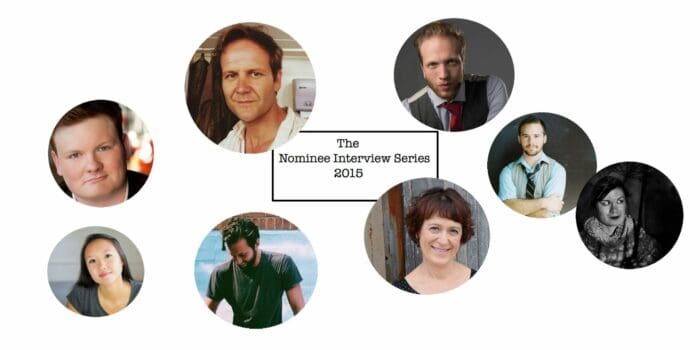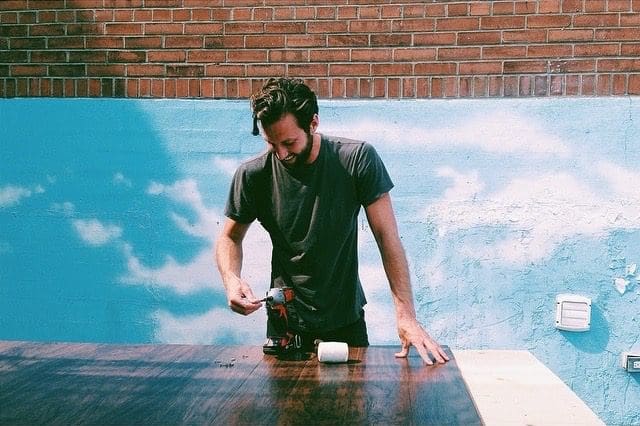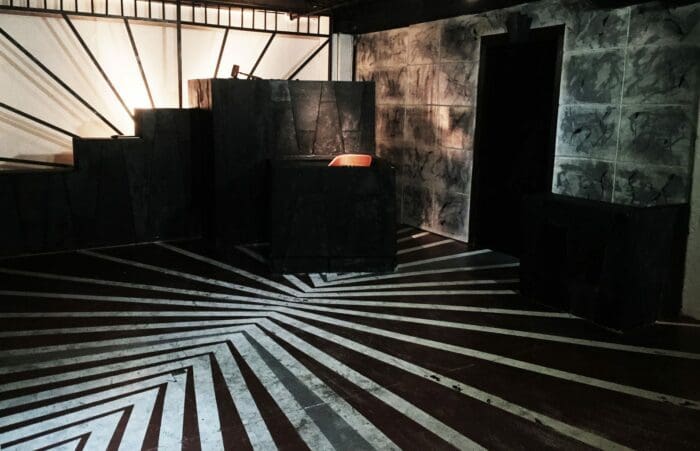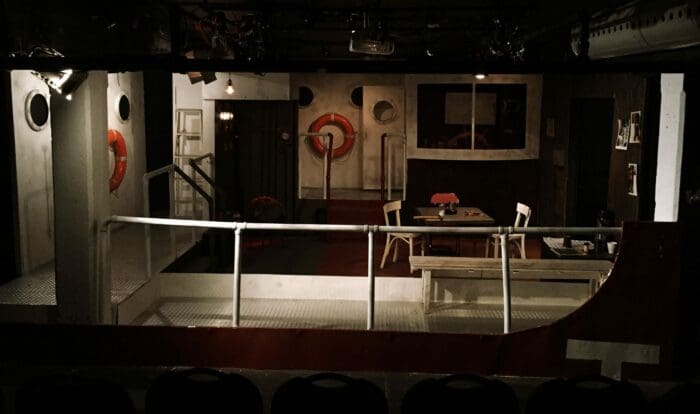 Before we announce the winners of the 2015 MyTheatre Awards, we’re proud to present our annual Nominee Interview Series.
Before we announce the winners of the 2015 MyTheatre Awards, we’re proud to present our annual Nominee Interview Series.
One of only a handful of people with multiple nominations this year, Adam Belanger is competing against himself with two standout set designs on one of Toronto’s smallest stages. Adam transformed the intimate Unit 102 Theatre first into a heavenly courtroom for the sprawling Last Days of Judas Iscariot then into an shockingly realistic looking ship for the slice-of-life Mamet play Lakeboat.
The double Outstanding Design nominee joins the Nominee Interview Series to talk about working with Unit 102 Actor’s Company and creating big worlds on a small budget.
 Can you remember the first theatre production you ever saw?
Can you remember the first theatre production you ever saw?
Boy that’s tough. I wasn’t around any theatre growing up. I’m from a small town, so I mostly saw school-related productions if any. I didn’t really get into theatre until university. I declared it as my major at the University of British Columbia after being rejected from the film program. I figured it would interest me just as well, and it did. The first production that stuck in my head there was Steve Martin’s Picasso at the Lapin Agile. I liked it because it wasn’t Greek, and it wasn’t Shakespeare.
How did you get into designing?
Opportunity and interest. Despite my major in theatre, after university I was still far too curious of work in film. I moved to Ottawa for a year and took classes at a Film co-op called IFCO. Then I moved to Toronto with a lot of hunger for being on set. Once on set, I drifted through departments. I was a PA to start, then became a grip, and then discovered the art department. I hadn’t even considered this department’s existence despite my interest in how films were made, even as a kid. I was drawn to the department because they would just come on set with cool things and then leave to go get more. They’d transform things and make certain things look like other things. That interested me a lot. So I became an art director’s assistant for a bit. Then I searched for opportunities to hold those reins myself until I could become a production designer. Being a handy guy helped move this process along.
What was the first show you ever worked on?
It was two shows at once actually. We were doing both David Mamet’s Oleanna and Neil LaBute’s In a Dark Dark House on alternating nights at Unit 102. Luckily this worked out well despite the fact that one play took place in an office and the other outdoors. Oleanna being a two-person play, we were able to shrink the office and leave the other outdoor setting visible out the office window. People took it as great attention to detail but it was kind of a happy accident.
How did you first get involved with Unit 102?
The same way I got involved in theatre, which was through David Lafontaine. We have a mutual friend and he had heard of me through him. At the time I was working as an art director on music videos mostly, and had also started building installations for Young Lions Music Club’s events. I guess my ability to switch-hit like this showed good promise. Anyway, the way it started was Dave came to me with this crazy idea that his theatre company would put money towards their sets. That was basically it. He told me about his idea to do two plays on alternating nights, and I bit. Ten productions or so later and I’m still working with those guys.

The Last Days of Judas Iscariot is a sprawling play that’s set in a heavenly courtroom with sojourns to countless other locations. Where do you start when handed a complicated piece like that?
I’d say the first thing I do is simplify. I look at the play and figure out what the necessities are. And by that I mean, what architectural elements are crucial to the play, how many entrances and exits are we working with, how many characters, and how does the play flow. After that we discuss how we’re going to stage it, which will then give me an idea of what needs to be where. Once that’s all understood I start thinking aesthetics. This is where things become a bit more conceptual for me. With Last Days, I was looking at the play knowing it came from Guirgis, and that a lot of New York street was in his head while penning it. Given the inherent imperial nature of courtrooms, not to mention one in Purgatory, along with this image of New York grit, I became very interested in the image of something sturdy but worn. Chiseled from stone. Most of my research was looking at the principles of Art Deco and the look of ancient ruins. Beyond that, the concept was minimal. It kind of had to be, considering the amount of characters passing through it and the size of the room. The key was not making it seem cluttered in that small space. It had to have a smooth and simple architectural flow.
The Unit 102 space is really tight and you were working on a small budget, how do you problem solve limitations like that?
Well one thing we started doing several plays ago, was introduce a second audience seating at times. This has been a very fun change to how we stage plays. For the actors it’s great as they get to play in multiple directions. For me its great because I get to consider more than one point of view for the audience, the second of which is often now positioned on the set more or less. At least that’s the feeling we try to create. For Last Days, part of the audience was seated as the jury. For American Buffalo they were in the pawnshop. For Julius Caesar they were within blood splattering range, outside the capital. As for budget, I just make it work. Limitations can be a good thing anyway.

Your other nominated set was much more practical but also much more elaborate. Tell us about your concept for Lakeboat.
Yeah, Lakeboat was an exciting challenge. When I first read it, I thought there was no way we could do it in that space. It takes place on a 615ft steel bulk freighter. Fitting that on a 300 square foot stage seemed next to impossible. But it wasn’t just because of the size; it was how fast the scenes moved along. The scenes are very short and take place all over the ship. I just couldn’t imagine how we’d stage it without it being choppy. Luckily the director, Scott Walker, assured me that he could make it move and keep it moving. I just had to figure out how to lay it out. I researched a lot about these ships and the style of the ones used in that era. Then I scrunched it. To build it though, the geography of the ship had to make sense in my head. I built it with four levels and had to think, okay, this entrance is going to represent coming off the dock onto the ship, then this will lead you into the engine room, but if you want to go into the galley you have to go back up and around the deck to go back down. No cutting across stage as that wouldn’t make sense. The set had to come with a lot of rules or it would just be too confusing.
What was your favourite design element in the detailed Lakeboat set?
The front of it. Or should I say the starboard side. To offer a bit of a clue as to how the ship was laid out, I wanted to be able to represent the exterior. So to illustrate this I built a slim border at the foot of the stage in red sheet metal. Then to illustrate the scale of the ship, I painted a section of the letter ‘T’, as the boat is called the T. Harrison. That letter is the only reference on the set to how big the ship actually is. Many people likely didn’t see it. Doesn’t matter though, much of the finer details on set are just for me.
How much guidance did you get from directors David Lafontaine and Scott Walker when developing your designs?
There’s an incredible amount of trust in that building. We’ve all worked so much together that we understand each other’s methods. When I begin a play with Scott or Dave we talk a lot about the play in theoretical terms. Where and when did the playwright write it, what was he or she likely getting at with the themes, also what does the play mean to them as directors, why did they pick it, etc. That’s how we get on the same page. But in terms of the actual design, they kind of leave it to me. We talk back and forth about what needs to be where so the blocking can begin and the actors can get on their feet, but they just kind of trust me when it comes to making something that is compelling and will work for what they need it to do. They’re both great for bouncing ideas off of though. Especially Dave, who I’ve built many sets with. He understands the process I go through quite well.
How long did each design take to implement?
Designing is one thing and building is another. I’ll generally start researching what the play offers in its text, and then start scribbling at a rehearsal. After that I begin rendering it to make sure it makes sense in that small space, then calculate how much it will cost to do what I want to do. I’d say from start to finish about 3-4 weeks. The build itself only being a week of that. Except for Lakeboat; that took a couple weeks.
Were you pleased with how the designs worked in practice?
Extremely. I’m always in awe of what goes on at Unit 102. To sit and watch such richly talented artists play on the set, and discover different ways of using it. It’s just so fun. And to hear the actors pleased with it is the most rewarding.
Do you have a favourite moment from either production?
That scene in Last Days when Satan, played by Brandon Thomas, is breaking down Cunningham, played by Nola Jean Martin. Such a powerful scene and they both killed it night after night. It’s of no surprise to hear of their nominations for those roles.
Other than that I’d say any time either Mark Paci or Anthony Ulc are on stage. And lucky for me they’re in both productions. Love those guys.
What would you say is your top priority in any design project?
I’d say discovering new territory. Which in a way is selfish because it’s about me being pleased with my work. But I don’t like doing things more than once. I like to play with new materials every time and really push myself to learn what can be done with what. With Unit 102, we’ve made so many different environments in that tiny space the question becomes what else can we do? The way Lakeboat started was basically me telling Dave that I really wanted to do a boat set. He said to talk to Scott, as he’s always wanted to do Lakeboat. So really that production was partially all of us pushing ourselves to see what else we can do in that space.
What’s your favourite design you’ve ever worked on?
This becomes a question every time I begin a new set at the theatre. Is this one the best? A new favourite? Does it beat out the others? The one I always look back on fondly is A Behanding in Spokane. I think that’s when I was really starting to get it. I also like building ugly sets. Sounds strange but the unsightliness of that shit hotel room is everything I could ever dream of.
What are you doing now/ what’s your next project?
At the moment I’m working on a TV series while letting the intermittent commercial or miscellaneous project undoubtedly pop up here and there. As for theatre, my next production will be Of Mice and Men at Unit 102 in April. David Lafontaine will be directing. I’m very excited for that one!
Do you have anything you’d like to add?
I suppose just a thank you for this interview and the nominations. Any dialogue about theatre makes me pleased, and this is a great avenue. Looking forward to the awards. Thanks to everyone who made it to the end of this.
